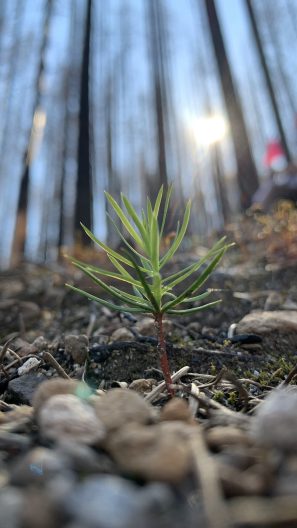
New research published by the SEFS Harvey Lab looks at how forests west of the Cascade crest in Washington and northern Oregon are recovering from recent large and severe fires. The answer? Surprisingly fast, when compared to many interior dry forests elsewhere in the western US. When it comes to recovery, the age of the forest prior to the fire had an impact, with old-growth forests showing more abundant and diverse tree seedlings establishing after the fire compared to forests that were younger and simpler in structure before the fire.
In other forests of western North America, post-fire tree regeneration has slowed or potentially stopped altogether in some cases due to increases in fire size, severity, or frequency in combination with warmer and drier post-fire conditions. However, even after recent large and severe fires, the burned forests on the west side of the Cascades are exhibiting rapid natural post-fire tree regeneration and forest recovery. 82% of stands where the fire was severe and killed all the pre-fire trees had post-fire regeneration rates that exceeded Washington state forest practice minimum density thresholds by 3-5 years post-fire, suggesting that, overall, naturally occurring tree regeneration is sufficient for meeting management objectives of forest recovery. Seedling density increased in areas with cooler and wetter conditions and with proximity to surviving live trees; but, surprisingly, tree seedlings were abundant at distances up to 400 meters from the nearest live tree. As lead author and PhD student Madison Laughlin put it “Seeing abundant post-fire tree seedlings at such far distances from live mature trees suggests we may be underestimating seed availability following severe fire in these forests. Seeds might be dispersing farther than previously thought, or some cones on trees that were killed by fire might persist, if not burned, and provide an on-site seed source. These are hypotheses we are currently testing in our ongoing research.”

This research highlights the importance of old-growth forests and suggests that the complexity in older forests promotes forest resilience to severe, stand-replacing wildfires. Because these areas burn infrequently relative to other drier forest ecosystems in the western US, little research has been conducted on post-fire regeneration in the region. As warming continues due to climate change and wildfire potential increases in northwestern Cascadia, it will be critical to understand how forests are re-establishing with trees after severe fire. “Post-fire recovery of forest ecosystems is something that can play out over very long time scales, especially in forests that are characterized in part by infrequent and severe fires. These findings are encouraging signs for forest resilience to these kinds of fires in the northwestern Cascades, and our future re-measurements of these plots will help us track long-term recovery”, mentioned SEFS Professor Brian Harvey, senior author on the study. “We’re also measuring multiple complementary response variables in coordinated studies so we can track things like the entire post-fire plant community as well as the post-fire fuel profiles and potential for subsequent reburns in these areas. This collectively is helping us build understanding of how fire affects a wide diversity of ecosystem components, and with our partners, co-develop strategies for managing that diversity pre- and post-fire.”
The study was published in the journal Forest Ecology and Management, led by SEFS PhD student Madison Laughlin with coauthors Jenna Morris, Liliana Rangel-Parra, and Brian Harvey from Professor Brian Harvey’s lab in SEFS, and Drs Dan Donato and Joshua Halofsky at the Washington Department of Natural Resources. It uncovers a critical piece in our understanding of forest resilience and managing post-fire landscapes. The findings suggest a high capacity for recovery from large and severe fires that are characteristic in forests west of the Cascades in Washington and northern Oregon—particularly in areas with old-growth forests.
This research was supported by a grant from the United States Geological Survey Northwest Climate Adaptation Science Center, the USDA Forest Service – PNW Research Station as part of the Westside Fire and Climate Adaptation Research Initiative, the Good Neighbor Authority between the USDA Forest Service and Washington Department of Natural Resources, the Jack Corkery and George Corkery Jr. Endowed Professorship in Forest Sciences, and support from Jerry Franklin.